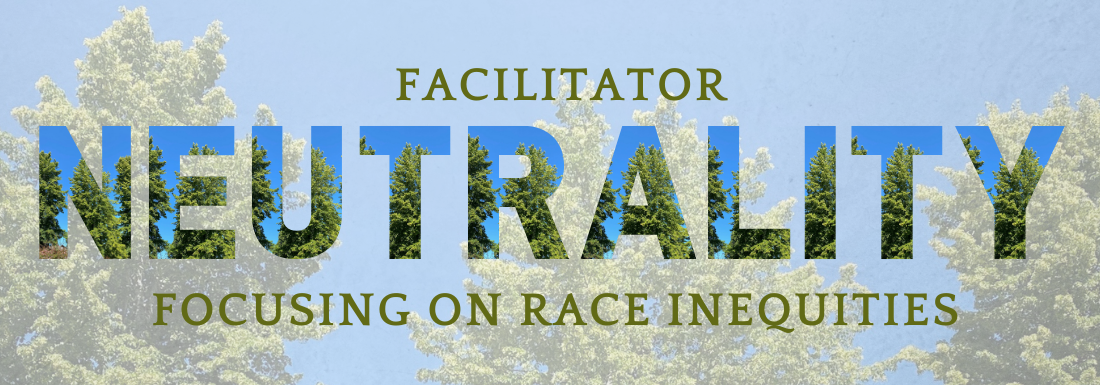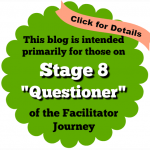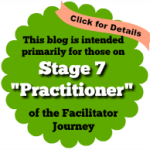When the Facilitator Must NOT Be Neutral

It’s been a month since we last wrote our blog. The tree embedded in the banner represents some big things the human race is finally speaking about on a global basis – race inequity and other forms of oppression. In many parts of the world there have been demonstrations about race, specifically triggered by deadly use of force by police officers in the USA. The movement has been named “Black Lives Matter”. We wanted to relate this topic of critical importance to the art and science of process facilitation. One key competency we often talk about in facilitation is neutrality. In this blog, we examine the subtler aspects of facilitator neutrality and specifically when it is not only appropriate but essential to NOT be neutral. These times of COVID-19 and race demonstrations call me to reexamine the concept of Facilitator neutrality. I may be inept at expressing what I am sensing but I don’t want to be silent about it.
I’ve addressed this to more advanced practitioners at Stage 7 of your journey but also included Stage 8 which is the Questioner stage (which is when one loses a sense of importance and you are asking “so why am I a facilitator?” . I’m hoping this blog reinvigorates your sense of purpose around your facilitator practice.
Let’s dig in…
For a starting point, non-neutrality means you care enough about every voice in the room that if you see/hear a power imbalance, oppressive remark or behavior toward any one person or group, you come to the defense of that person or group immediately. You act compassionately and swiftly towards the person who intentionally or ignorantly showed bias or oppressive action. You do not remain neutral about seeing action that can be hurting people. No one in your room should ever be hurt. That’s the starting point for me around non-neutrality. You want to be hyper alert to oppressive acts (including your own). Do not “sit on the fence” because you do not want to take sides, or be seen to favour one person over another. In fact, by sitting on the fence when an oppressive act occurs, you are taking sides in favour of the oppressor. We’ll come back to examples of how to practice neutrality but not be neutral to oppression or violence.
Now let’s look at what we typically mean by facilitator neutrality. I asked a few of our long term cohort members about their ideas of what it means to be a neutral facilitator.
Farah Shahed from India says, “The neutral stance is to offer a space that is safe, non-judgmental and in service to the group. I’m willing to meet them where they are and I don’t try to push them where I want them to go.” We’ll come back to this phrase later, because there are some situations where you may need to push them where they do not want to go.
Grace Tan from Singapore says for her neutrality means “not leading the group to certain content or a certain direction. It is allowing the group to decide the content and the direction.”

Lyn Wong also from Singapore shares that “neutrality is about being aware of and managing your own biases”. She also notes “it is often easier to be neutral towards the content of the session as an external facilitator than for an intenral facilitator who may have been given a direction to take the group by another leader.”
Similar to Lyn’s point above, Farah also notes that we all come into the room (virtual or in-person) with our own “frames” or sets of experiences and expectations. Farah says for example, that she judged a group once for being “unproductive” in her own mind, and thus she brought her own frame of impatience. So neutrality is not judging the group’s progress or handling of a discussion.
Subtleties of Neutrality
Grace goes on to share that the role of the facilitator is to look after the group dynamics. That includes balances in power and creating conditions that ensure everyone’s voice is being heard properly. The facilitator might see something important that the group is not seeing. When this happens you need to find a way to share this with the group if you think it will help them make a breakthrough. Here’s some examples of staying neutral yet still helping the group uncover something that may have missed. I specifically chose phrases that might help them think about underrepresented voices in their organizations.
Example: “I heard the group express this and this and this…
- If these other people who are not here today were in the room, what might they add?
- Or, what might be missing from this list you created?
- Or, imagine seeing your black, indigenous or people of color leaders are looking at your output/ policy/ decision, what would not be clear to them? What would they say needs to be added?
- Or, imagine your employees are looking at this list. What would they add or not be clear about?”
The most daring I have been on the edge of not being a neutral facilitator is, “I heard in some of the confidential interviews with your group that this issue [name the issue] is important to you. Yet I didn’t hear you raise it today. Why is that?”
Think about those example phrases – do they breach neutrality for you? Or are they “in service to the group” or to the well being of the overall organization?
How to Be Non-Neutral When People in the Group are Mistreated/ Oppressed
Grace reminded me that we need to be careful how we perceive things in the meeting. Are we more sensitive to some comments than others? We might be over protective of the women in the group if they under represented. Or we might be over protective of the darker skinned people, if you are darker skinned yourself or have many friends from that group. And yet, we must remember that to be an effective ally, we don’t need to be over protective. Some of our actions will be seen as paternalisitic if we step in too soon or when not needed. Disclosure: I often wait too long to step in though because I don’t want to be paternalistic.
There are many times though when we do need to step in because we notice something that doesn’t feel “right” in our bodies. This is a great clue. This body awareness needs to be cultivated in all of us as process facilitators. It might be a sharp pain in the gut, sweat arising, a feeling of discomfort or slight nauseousness. Resmaa Menekem talks about these somatic (body-based) experiences in his book “My Grandmother’s Hands- Racialized Trauma and the Pathway to Healing our Hearts and Bodies” (noted in resources below). He talks about the importance of acknowledging our (often unconscious) inner body reactions to people who are different from us.
Another great clue is that we may notice the body language of some of the participants in the room. Something just happened that needs to be brought to the attention of the group. So, here are two clues when to step in:
- Your own internal “feels off” reaction to something that was said or done, and
- We notice something happening to the group that shows us they are “shutting down” or having another type of reptilian/ lizard/ primal brain reaction.
Example: You just noticed a white male leader roll his eyes when a black female participant offers a suggestion. You look at the black female participant and see her look of resignation, frustration or defeat. You might first ask yourself, am I being over sensitive to this behavior? Not likely! If you were paying attention and you noticed these things in a split second, you do need to find a way to share what happened that allows the room to feel safe again…e.g.,
- “Frank, I just noticed that you rolled your eyes (or spoke over) when Amara shared her idea. I’m not sure what you’re feeling or thinking right now but I did notice that it had a potentially negative impact on Amara and likely for others in the room. Would you be willing to share what’s going on for you right now?“
- Then you might turn to Amara and say, “Amara, what was going on for you when you saw Frank’s expression or he spoke before you finished your thought?” or,” How did you react when you saw his facial expression/ did not get to complete your thought?“
This is part of what I mean about being non-neutral. It also reminds me to come back to what Farah noted above: “Not to push them where I want them to go.” You may in fact need to be pushing them to look at something they are afraid to look at. That is OK. In the face of oppression, some of the group will not want to go there, but some of the group is expecting you to go there. You do not want to sit on the fence; nor do you want to take sides with either the oppressor or the victim. Instead, you want to check out the impact of an act on a person or a group. Once you help the group uncover what happened, and make sense of it, people can begin to heal.
This example above of Frank and Amara above will generally work better if you set a context with the group at the beginning, e.g., “My job is to create a safe space for everyone to participate. If I see words, actions or behaviors that may not be contributing to safety and inclusion, I’m going to let you know what I’m sensing and noticing. Can I get your agreement to do that?”

This is just a VERY light touch on a topic that is especially important for these times where race demonstrations are happening all over the world. Inequities and disparities are surfacing in very visible ways because of COVID-19 and greater awareness is finally building within the dominant white culture in the world. I wanted to share this thinking because we can’t let it go on uninterrupted anymore. It’s not ok to give the excuse that you’re being neutral when you are not interrupting the constant inequity in the room. The neutral facilitator concept was never meant to stop us from interrupting hurtful behavior.
For the rest of this blog I’m going to share some resources on race that I have found especially beneficial in the last few weeks. Everything I share with you I have either read or attended classes in the last month or comes recommended by trusted colleagues. I highly recommend all of them if you, as a person who is not black or dark skinned, are willing to educate yourself more.
May you realize the work of process facilitator is invaluable and may you continue to gain mastery in it. This is our edge right now. Care to travel with me on this edge?
Resources
Resources related to “Black Lives Matter” context for today: to educate yourself, give you courage and clarity to be an activist, support Black entrepreneurs and interrupt racial acts of oppression.
My Grandmother’s Hands: Racialized Trauma and the Pathway to Mending Our Hearts and Bodies by Resmaa Menekem, 2017. Includes historical context for centuries old traumas in White, Black and Polic “bodies”. Gives frameworks and “settling exercises” to practice such as humming, rocking back and forth, rubbing feet and belly, deep breathing so they we do not confront others before our bodies are settled and minds cleared.
Here is an audio of me humming to myself as an example when I walk around the neighborhood.
Says colleague, Theresa Logan (see more below), “In a time when we are experiencing a collective global trauma and the individual stresses and traumas of how it impacts each of our lives, this book offers practical skills for self-regulation, collective regulation and “metabolizing” our traumas, while centering the racial analysis we need to build new systems and cultures not rooted in white body supremacy. I certainly don’t know what the world will look like on the other side of the COVID-19 pandemic, but I do know we’ll be in a better position to organize and leverage our individual and collective power and resources if we are grounded in our values and acting intentionally from the “best parts of ourselves” rather than defaulting to habits and reactions rooted in personal, intergenerational and historical trauma.”
The author himself, Resmaa Menakem, also is offerring a free 5-day home study course!
Insight Timer: This is an app I’ve used for decades to practice meditation. There are many great Black contributors. Support them by taking their courses or listening to and rating their offerings. I’ve really liked these Black meditator offerings lately. Use search function on word “racial” to find more:
Skip Jennings – An Honest Conversation of Social Justice and Injustices
Valerie Brown – Cultivating Metta for Everyone
Andrea Kane Frank – Loving kindness in Honor of George Floyd for Racial Healing
Joseph McClenton – Bridging the Racial and Cultural Divide
Podcast:
The most recent episode 82 of podcast “That’s Not How it Works” gives a great summary of some of the hosts (Trudi and Weeze) most important episodes. Trudi and Weeze are two Black women from Oakland, California who offer coaching and resources for white allies. You can listen on Apple podcast. This podcast is recommended by a USA colleague, Theresa Logan, who ran a book study on “My Grandmother’s Hands” noted above. I trust her a lot. Check our her FB post here.
Here is also a podcast I’ve enjoyed “On being ” with Krista Tippett. This episode interviews Resmaa Menakem, author of book noted above:
Esteemed IAF facilitator and consultant Indian colleague, Vinay Kumar started a new podcast called “Shiny Happy People” Listen on Spotify here – Check out this one on Diversity and Inclusion
Article:
Academic article on the history of racism and how mindfulness can be a great act to overcome racism: Confronting Racism with Mindfulness Confronting Racism with Mindfulness
Group Classes/ Support Groups to Join:
Esteemed Diversity & Inclusion USA colleague Rhodes Perry of “Belonging at Work” has been holding weekly discussions on equity issues. Register here.
Eva Jo Meyers, esteemed ToP USA of “Spark Decks” is offering a series of different equity issues over the summer. Here is the link to register for a session on Facilitating Dialogues About Race and Racism with Dr. Colette Cann.
Declaration of Solidarity
Here is one from my own ToP Facilitators Network in the USA:
This statement perhaps can be an example of what you’d like to see created in your own organization. Part of it is reprinted here.
In times like these, we must not be silent. Rather, we must uplift the voices of the Black community, confront White Privilege, and acknowledge our own privileges, implicit biases, and the ways in which we individually and collectively uphold the destructive forces of systemic racism and white supremacy.
We represent a community of ToP practitioners who seek transformative change towards a society of profound respect and inclusive participation. Our methods have the power to dismantle hierarchical structures and oppressive systems and cultivate real understanding of one another’s humanity. As facilitators we seek to help communities reach consensus, shared understanding and shared action.




Hello Barbara! I just found your work and I love it! Thank you for bringing this work to other facilitators.